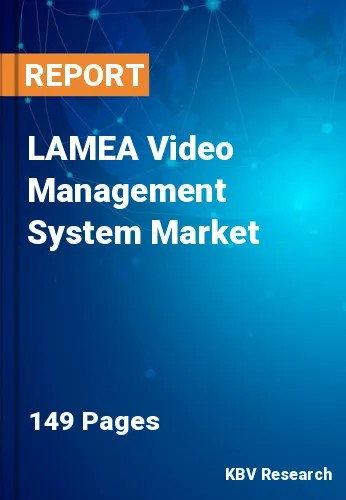The Latin America, Middle East and Africa Video Management System Market would witness market growth of 25.3% CAGR during the forecast period (2022-2028).
Customers have the convenience of remote video monitoring and monitoring over various places in one location. To ensure that footage doesn't terminate, the organization is responsible for physically securing the local equipment and enforcing good video access control. Video management systems make use of cutting-edge technologies, like advanced robotics, artificial intelligence, machine learning, and the cloud.
Such technologies simplify the gathering and organizing of all the data obtained by other security measures and offer a thorough examination of security visibility and analytics that can then be utilized to develop an effective threat response strategy. Ultimately, this high-level concept of security should combine processes, people, and technology in an effective way in order to minimize risk and close gaps and silos in the security footprint.
When one threat, either physical or digital, has been recognized, human operators could utilize their knowledge and the information given by video management systems to promptly implement the appropriate response while avoiding time-wasting false alarms and delayed security threat intelligence gathering. Moreover, based on the data collected, the machine learning part of the video management system software aids operations employees in identifying areas of weakness, boosting security operations, and averting potential dangers in the future.
The regional video management system market will expand due to expanding internet penetration and a rise in smartphone users. Additionally, these technologies help businesses strengthen communication among personnel who are dispersed across several places. This would help to meet the region's rising demand for these solutions. Key market players can expect new growth opportunities as the bring your own device (BYOD) movement among SMEs gains traction.
The Brazil market dominated the LAMEA Video Management System Market by Country in 2021, and would continue to be a dominant market till 2028; thereby, achieving a market value of $671.4 million by 2028.The Argentina market is experiencing a CAGR of 26% during (2022 - 2028). Additionally, The UAE market would display a CAGR of 25% during (2022 - 2028).
Based on Technology, the market is segmented into Analog-based and IP-based. Based on Vertical, the market is segmented into Retail, Telecom & IT, Manufacturing & Automotive, BFSI, Government & Public Sector, Healthcare & Life Sciences, Education, Energy & Utilities, Tourism & Hospitality, Transportation & Logistics and Others. Based on Component, the market is segmented into Solution and Services. Based on Services Type, the market is segmented into Professional and Managed. Based on Deployment Type, the market is segmented into On-Premise and Cloud. Based on Application, the market is segmented into Security & Surveillance, Storage Management, Data Integration & Case Management, Advanced Video Management & Video Intelligence, Custom Application Management, Mobile Application, Intelligent Streaming, and Others. Based on countries, the market is segmented into Brazil, Argentina, UAE, Saudi Arabia, South Africa, Nigeria, and Rest of LAMEA.
Free Valuable Insights: The Global Video Management System Market is Predict to reach $34.8 Billion by 2028, at a CAGR of 22.2%
The market research report covers the analysis of key stake holders of the market. Key companies profiled in the report include Robert Bosch GmbH, Honeywell International, Inc., Schneider Electric SE, Axis Communications AB (Canon, Inc.), Johnson Controls International PLC, Hangzhou Hikvision Digital Technology Co., Ltd., Verint Systems, Inc., Genetec, Inc., Panopto, Inc., and Eagle Eye Networks, Inc.
By Technology
By Vertical
By Component
By Deployment Type
By Application
By Country
Our team of dedicated experts can provide you with attractive expansion opportunities for your business.

